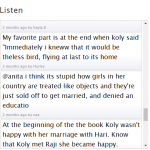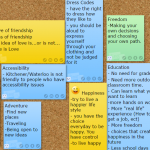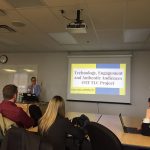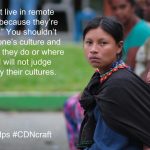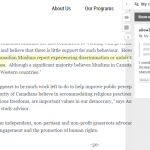We worked collaboratively with our students and peers over the course of the year to create a classroom environment that incorporated student interests and curriculum, but where, unlike a traditional grade school classroom, students were engaged in learning and knowledge building with authentic audiences, both inside and outside their own school. Using multiple digital platforms, we built the capacity of our students to work with a variety of web-based applications, and to have virtual conversations with students and adults in their community and across Ontario.
Team Members
Laurie Mackechnie
Waterloo Region District School Board
Elke Baumgartner
Waterloo Region District School Board
Professional Learning Goals
- We improved our competency in how to evaluate, use and connect multiple learning platforms (e.g., Google Hangouts, Mindomo, Hypothes.is, D2L, Padlet, Linoit, TodaysMeet) to provide students with learning and knowledge-building opportunities with authentic audiences
- We learned more about understanding Terms of Service/use of applications
- We built our capacity to connect student interest and choice to language, history and geography curriculum
- We learned more about the challenges and planning required to get students working with students outside their school and community
Activities and Resources
Activities
- Collaboration with the digital literacy support teacher
- Collaboration with teachers from within home school, in the region, and in other areas of Ontario
- Attending professional development related to using technology in the classroom (BringItTogether BIT2016, GAFE summit, ASET conference, CATC camp)
- Regular collaboration and discussion with students about the effectiveness of digital applications, and the successes and challenges of online learning
Resources
- Access to 1:1 Chromebooks for the duration of the project
- A variety of digital platforms, that promote collaboration
- Mindomo – mind maps
- Hypothes.is – online collaborative annotation
- Google Hangouts – for co-ordinated video chats with students in Ontario
- D2L online course (#CDNcraft) – online learning forum where students commented, read each other’s posts, shared media projects, and received feedback from peers and adults
- Padlet, Linot – Virtual corkboard/white board which allowed students and teachers to collate, post resources and ideas, comment on questions, build knowledge, and share background knowledge
- TodaysMeet – Virtual chat room where students had real-time, online discussions about books they were reading
- GAFE, Google Classroom – workflow management tool which helped connect teachers to student work
Unexpected Challenges
- Originally, we had thought that when students were writing online for authentic audiences, we might see an overall improvement in student writing (convention use especially) because students were more motivated by “real tasks” (tasks that were not just for teacher marking). We did not really see what we had expected. However, what we did notice was that as students read ideas posted by each other and students outside their class, they became more critical of each other’s writing because they could not understand the message. In turn, they began to look more critically at the clarity of their ideas and coached each other.
- Connecting with classrooms outside our school was more challenging than we had originally thought (i.e., co-ordinating schedules, start times and accounting for disruptions)
- Students felt one of the unexpected challenges involved disappointment and frustration when working on group tasks online. They felt that sometimes when working online there were a lot of inconsistencies with the quality of information being shared or a lack of sharing/posting.
Enhancing Student Learning and Development
- Students were able explore their own interests of learning through broad inquiry questions, which connected to curriculum. They built their understanding of their community, country and world.
- Over the course of the year as students interacted with authentic audiences across digital platforms, they learned to use real-time feedback from other teachers and peers (real-world audience) to improve their communication skills, and confirm or shift their thinking.
- Students built their knowledge not just from print resources and teachers, but from other students across grades in different schools. One of the most powerful learning moments for students came from a video chat where a student from a different school and cultural background disagreed on a point and shared his own personal experience. That first-person account was invaluable to their learning.
- Students grew their collaboration skills as they worked together with different groups on shared interests, and became experts in different media platforms helping their peers improve their skills. This became, in our opinion, one of the greatest impacts of the project. Students in the classroom sought out opportunities for feedback from each other and collaboration on ideas.
- Students who did not take part in small group oral discussions found their voices using digital platforms. Students commented that by talking online, they had more time to compose their ideas, their confidence increased because they could see what ideas others had shared, they could be more confident that they were on the right track, and they could post under a pseudonym (which online the teacher knew).
Sharing
The Waterloo Region District School Board hosts a digital symposium twice a year where teachers are invited to share their experiences with technology in the classroom. During both of those symposiums (fall/spring), the successes and challenges of our project were shared to teachers from across our school board. At the symposium, my target audience was intermediate teachers. I shared information through conversation and a Google Slide presentation.
Teachers from my school and one other in the region have also been invited into my classroom to observe. As a result, we also had collaboration sessions in order to include their classrooms in our online collaborations.
Project Evaluation
We are very happy with the outcomes of our project. We did not achieve everything we had originally set out to do as part of the project, but what we did achieve had an impact on our learning and teaching, as well as student learning.
When we thought about evaluating our success, we considered how we were able to use technology to redefine our classroom. Over time, classrooms have moved from students sitting in rows and working primarily independently, to groups of desks or tables where students collaborate more often to build knowledge. By building our capacity to use technology and collaborate (and the capacity of our students), we were able to reach outside our classroom walls and give students the opportunity to build knowledge, and collaborate with students outside their school and region. Maybe this hybrid version of learning in the classroom and connecting with others beyond our walls is what the next “classroom” will look like.
We also measured our success by what we saw as increased engagement and motivation in our students to strive for success. Much of the learning and work students did was no longer just for their teacher, parents or peers. It had a real purpose. As students worked together to answer questions like “How did Canada become a country?” or “What does being a great Canadian look like?,” or they prepared media presentations about stereotypes in Canada, or crafted their answers to questions they would share during a Google Hangout, they knew that their work would be on a public forum. They asked for opportunities to practise and they grew to naturally ask each other for feedback and ideas.
Finally, we feel we achieved success because we grew from connecting in our classroom to connecting across Ontario. We started small by using these platforms within our classroom to connect students, then we moved to within the school, then within our board, and then to now at the end of the year where we were able to connect with a project that connects us to students in different grades in schools across Ontario. This approach was deliberate and we feel it attributed to our success because by the time our students connected with students outside our school, we had well-established guidelines for online conversations, and had built strong skills in digital literacy and digital platforms.
Resources Created
These resources will open in your browser in a new tab, or be downloaded to your computer.


